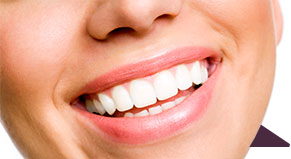Translucent Teeth: How to Fix Before it Gets Worse
May 19th, 2016
 Teeth are called pearly whites for a reason. They should be white - not see-through. Along with affecting your appearance, translucent teeth can also signal that something more serious is going on with your teeth. Teeth typically begin to appear translucent when enamel is thinning.
Teeth are called pearly whites for a reason. They should be white - not see-through. Along with affecting your appearance, translucent teeth can also signal that something more serious is going on with your teeth. Teeth typically begin to appear translucent when enamel is thinning.
Causes of Translucent Teeth
Wonder why your teeth are becoming ghost-like? It could be a result of acid erosion. If you’re not taking proper care of your teeth, acids in your food and drinks can begin to eat away at your enamel. Very acidic foods include soda, pickles, red wine, tomatoes, and citrus fruits.
Translucent teeth due to thinning enamel isn’t always your fault. Several conditions can cause this issue as well. If you have severe enamel hypoplasia, your enamel will lose minerals and your teeth will appear translucent. This condition is a side effect of both genetic and environmental factors, and occurs when your teeth are developing. Celiac disease can also lead to issues with the development of your enamel. Finally, conditions like bulimia, morning sickness and acid reflux (GERD) can cause acids to erode your tooth enamel.
As you can see, enamel erosion or thinning can be caused by a wide variety of factors. It’s best to visit your dentist to figure out exactly why you’re experiencing translucent teeth so that you can halt the thinning as soon as possible.
How to Fix Translucent Teeth
Once your enamel is gone, it can’t regrow naturally. However, there are some ways the doctor can remineralize your teeth and make them appear whiter and brighter again.
 Enamel Remineralization: During enamel remineralization, your doctor will open up the “pores” in your teeth and penetrate the tooth with calcium phosphate, sodium fluoride and Recaldent. This combination of ingredients will act like enamel by improving the appearance, strength and sensitivity of the tooth. Not only will your teeth be whiter, but they will also be more resistant to acid erosion and decay, will be less sensitive and have less white spots, or none at all. You can see a picture of one of our patient’s teeth before and after enamel remineralization to the right.
Enamel Remineralization: During enamel remineralization, your doctor will open up the “pores” in your teeth and penetrate the tooth with calcium phosphate, sodium fluoride and Recaldent. This combination of ingredients will act like enamel by improving the appearance, strength and sensitivity of the tooth. Not only will your teeth be whiter, but they will also be more resistant to acid erosion and decay, will be less sensitive and have less white spots, or none at all. You can see a picture of one of our patient’s teeth before and after enamel remineralization to the right.- Veneers: If you want to purely improve the appearance of your teeth, veneers will take the translucency out of your smile. Veneers are simply placed on top of your teeth to cover up the translucent color. You can either choose to receive either traditional porcelain veneers or time-saving minimal prep veneers, depending on your needs and budget.
Steps to Prevent this Problem
While you can’t prevent enamel hypoplasia or celiac disease, you can prevent acid erosion from foods or from conditions like bulimia, acid reflux and morning sickness. Immediately after you eat acidic foods, throw up or experience acid reflux, it’s important that you wash your mouth out with water. Do not brush your teeth right away. Since acids make your enamel more vulnerable, brushing immediately could do more harm to your enamel. Wait at least 30 minutes before you brush, and use mouthwash to ensure you wash all of the acids away.
Worried about your translucent teeth? Don’t be afraid to call Chicago’s #1 dentistry, Water Tower Dental Care. We’ll be happy to discuss what may be happening to your teeth and put together a treatment plan for you. You’ll be on the path to a healthy set of pearly whites in no time!

 Everyone hates teeth discoloration, which is why whitening strips are so popular. But what do you do when the discoloration appears in the form of white spots on your teeth? Although these spots are primarily a cosmetic concern, they can affect oral health and should be treated.
Everyone hates teeth discoloration, which is why whitening strips are so popular. But what do you do when the discoloration appears in the form of white spots on your teeth? Although these spots are primarily a cosmetic concern, they can affect oral health and should be treated.
 The last thing you want is yellow teeth after years of wearing braces. But unfortunately, it’s a very common occurrence. If you don’t take care of your mouth while you’re wearing braces, you might be surprised to see white squares where your braces were on yellow-stained teeth after your dentist removes them. Thankfully, it’s easy to avoid this experience. Here are some reasons why people get yellow teeth after braces and how to prevent this from happening. We’ll also talk about how you can fix stained teeth after braces.
The last thing you want is yellow teeth after years of wearing braces. But unfortunately, it’s a very common occurrence. If you don’t take care of your mouth while you’re wearing braces, you might be surprised to see white squares where your braces were on yellow-stained teeth after your dentist removes them. Thankfully, it’s easy to avoid this experience. Here are some reasons why people get yellow teeth after braces and how to prevent this from happening. We’ll also talk about how you can fix stained teeth after braces.
 We spend a considerable amount of time discussing the
We spend a considerable amount of time discussing the  1. Soda
1. Soda 2. Pickles
2. Pickles

 6. Saltine Crackers
6. Saltine Crackers 7. Sports and Energy Drinks
7. Sports and Energy Drinks




 Website Powered by Sesame 24-7™
Website Powered by Sesame 24-7™